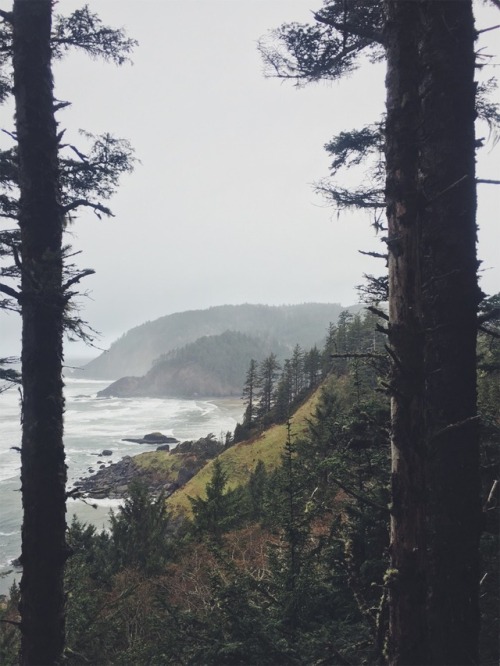225 posts
Latest Posts by rocks-everywhere - Page 2
What if... what if I WANT an info dump???
Then you're my favorite and I will dump SO much info on natrocarbonatite lava
No one knows for sure why or how this type of lava forms. Oldoinyo Lengai is the only volcano on earth that actively erupts it currently, and Oldoinyo Lengai hasn't been extensively studied.
The factor that causes lava to be viscous (thick, and sticky) is its silica content. Rhyolitic magmas, like those in Washington, have around 70 weight % silica. Basaltic magmas, like the volcanoes in Hawai'i, are around 45 wt% silica. Natrocarbonatite lava is less than 3% silica. Its flow rate is close to water, so it flows faster than you can outrun.
It's also a LOT less hot than other lavas. Most lavas are from 700-1200 degrees C (basaltic lavas in the higher range, rhyolitic lavas in the lower), but natrocarbonatite is around 500-600 degrees C. It's cool enough that you won't immediately die if you fall into it (you'll be hospitalized for months, as one man who fell into it was, but it's survivable). It's so cool that you can't see it glow in daylight.

It flows black and cools white! This is because of its content of the minerals nyerereite and gregoryite, which are unstable and break down quickly when exposed to humidity.
Basically it's cool as fuck literally and figuratively and I'm obsessed with it
Summer Dreaming

At this time of year, the sight of some battered bird-built structures can trigger summer dreams. Consider the Baltimore Oriole nest dangling from a linden branch above a Flagstaff Hill sidewalk in Pittsburgh’s Schenley Park. Watch the bundle of plant fiber and ribbon scraps sway in a cold late winter wind and you might be able to imagine the nest partially concealed by bright green leaves and periodically visited by a bird with goldfish-orange feathers.

Baltimore Oriole pair in CMNH Bird Hall with nest and nest cross-section.
Such out of season thoughts are far from original. One hundred and sixty-one years ago, and some 500 miles northeast of Pittsburgh, naturalist Henry David Thoreau used a different common name for the species when he referenced the bright and melodic warm season residents in a winter journal entry.
What a reminiscence of summer, a fiery hangbird’s nest dangling from an elm over the road when perhaps the thermometer is down to -20, and the traveler goes beating his arms beneath it! It is hard to recall the strain of that bird then.
Henry David Thoreau – journal entry December 22, 1859
Patrick McShea works in the Education and Visitor Experience department of Carnegie Museum of Natural History. Museum employees are encouraged to blog about their unique experiences and knowledge gained from working at the museum.

Glendonite star fossil
This fossil is not of an animal, but a mineral. When sea water temperature at the seafloor drops below ~4°C/39°F a carbonate mineral called ikaite will start to precipitate and grow forming bizarre shapes. Even though the original mineral will dissolve once it is buried, other diagenetic minerals will replace its form, making a glendonite.
Gledonite/Ikaite and its specific forming conditions allow geologist to approximate climatic conditions for the time period captured by the rocks in which this mineral is found.
Thanks to the flat exposure on the rock platform, we can appreciate this nature’s creativity.
Example from the south coast NSW, Australia.
⦕⁅⁅⁅ɔ ⦕⁅⁅⁅ɔ ⦕⁅⁅⁅ɔ ⦕⁅⁅⁅ɔ ⦕⁅⁅⁅ɔ
you have encountered a group of trilobites! reblog to help them on their journey






Villanueva State Park, New Mexico
When Dwarfs Meet Giants, and Other True Cosmic Fairy Tales
It’s easy to get lost in fantasy worlds through science-fiction movies and novels, but did you know that some of your favorite fairy tale characters actually exist in cosmic form? From dwarfs and giants to shape-shifters and buried treasure, the universe is home to a multitude of mystical objects.
White Dwarf Stars

You’ve probably heard of dwarfs like Happy and Sneezy (or Gimli and Thorin), but it’s unlikely you’re familiar with the space-dwelling dwarfs with names like Sirius B and ASASSN-16oh. White dwarf stars like these are typically about the size of Earth, which is pretty small as far as stars go. They represent one of three final stages of stellar evolution, along with neutron stars and black holes. Each star’s mass determines which one it will ultimately become. Stars much more massive than the Sun typically become neutron stars or black holes, and lower-mass stars end up as white dwarfs.

Our Sun will eventually become a white dwarf after it exhausts its fuel, but don’t worry — we’ve got several billion years to go! Before it is reduced to a white dwarf it will actually expand into a red giant, swelling out to encompass Earth’s orbit. But we don’t have to wait billions of years to see stellar giants … some already peek out at us from the cosmic deep.
Giants and Supergiants

The red giant star Aldebaran, located about 65 light-years away, is about 5,000 times bigger than Earth. Our Cassini spacecraft imaged Aldebaran through Saturn’s rings in 2006, but you can see it for yourself during northern winter. Just look for the brightest star in the constellation Taurus.

Fairy tale giants may be taller than trees, but these supergiant stars can be over 100,000 times “taller” than our entire planet! Supergiant stars are likely becoming more rare as time goes on. While scientists believe they used to be more common, our whole galaxy now contains just a small smattering of supergiants.

These massive stars grace the galaxy for a relatively small amount of time. They burn through their fuel extremely quickly — in just a few million years, as opposed to hundreds of billions of years for the smallest stars! Supergiants often end their lives in dramatic explosions called supernovae.

Betelgeuse — the bright, reddish star marking the shoulder of Orion — is nearing the end of its life and has expanded to become a red supergiant star. It is destined to explode as a supernova, which might happen tonight … or within the next few hundred thousand years.
Ghostly Solar Neutrinos

Even an average star like our Sun has some seemingly magical qualities. Each second, it sends billions of phantom-like neutrino particles out into space. They travel almost as fast as light and don’t usually interact with normal matter. Billions of them are zipping harmlessly straight through your body while you read this. Even at night they go through the entire Earth before reaching you!

But that’s not all … these ghostly particles are shape-shifters, too! Neutrinos can change characteristics over time, morphing between different versions of themselves. Spooky!
Buried Treasure in the Heart of the Galaxy

Extensive clouds of dust enshroud the heart of our Milky Way galaxy, hiding it from our view — at least when it comes to visible light. The dust isn’t as big a problem for infrared light, however, which has allowed us to get a glimpse of our galaxy’s chaotic core thanks to our Hubble and Spitzer space telescopes.

Future missions may peer into the galactic core in search of buried treasure — thousands of planets orbiting distant stars!
Want to learn about more cosmic objects? Find them here!
Make sure to follow us on Tumblr for your regular dose of space: http://nasa.tumblr.com
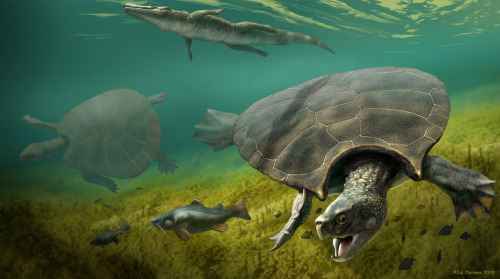

Paleontologists Find New Fossils of Gigantic Freshwater Turtle
http://www.sci-news.com/paleontology/stupendemys-geographicus-shells-08131.html

One of my students left her salt water out over the 4 day weekend and these beautiful crystals formed.
I miss doing microscope work. Can we make a thread of our favourite thin section? This is mine
Actinolite Schist

I miss doing microscope work. Can we make a thread of our favourite thin section? This is mine
Actinolite Schist

You Don’t Have to be a Rocket Scientist to Conduct Research in Microgravity

Putting your life’s work on top of a rocket may seem like a daunting task, but that’s exactly what scientists have been doing for decades as they launch their research to the International Space Station.
This season on #NASAExplorers, we’re exploring why we send science to space, and what it takes to get it there!

Watch this week’s episode to meet a team of researchers who are launching an experiment to space for the first time.
Follow NASA Explorers on Facebook to catch new episodes of season 4 every Wednesday!
Make sure to follow us on Tumblr for your regular dose of space: http://nasa.tumblr.com

The importance of a good and matching teacher or supervisor. You see, even birds can struggle with an inconvenient teaching style.
“It might be imagined that the most brilliant birds would be able to learn at any tempo, whereas others would learn well only when tutored at a slow tempo. But Mets and Brainards’ results demonstrate that this is not the case. Most remarkably, birds that were genetically tuned to sing slowly were not inherently worse learners. In fact, they often learnt better than the fast birds once the tutoring tempo ‘resonated’ with them.“
From the article: Tchernichovski and Conley. A genetically tailored education for birds, Nature 2019, 575. https://www.nature.com/articles/d41586-019-03416-4
Astronaut readjusts to life back on Earth
> Don’t give him a baby for a while.
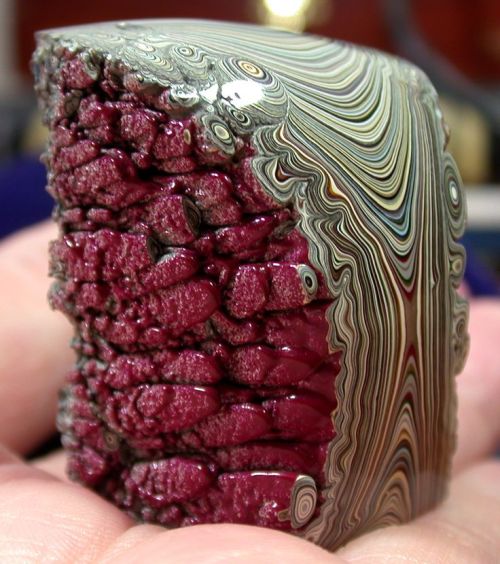
Fordite, also known as Detroit agate, is old automobile paint which has hardened sufficiently to be cut and polished. It was formed from the built up of layers of enamel paint slag on tracks and skids on which cars were hand spray-painted (a now automated process), which have been baked numerous times.










happy palentines day, geology edition
bonus

paleontology ones
The end-cretaceous extinction is actually very simple. The asteroid caused all the dinosaurs to bounce up into the air like a trampoline, and only birds, who could fly, could survive falling from such a height
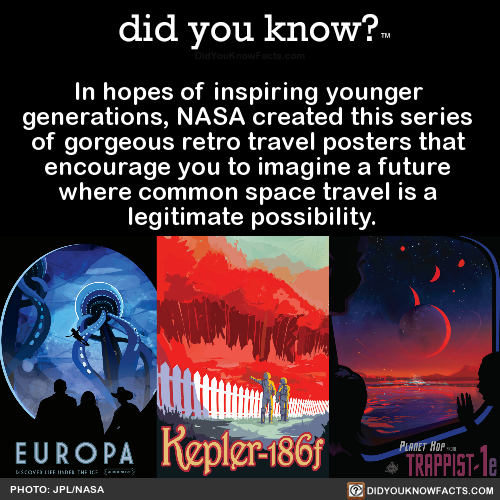
In hopes of inspiring younger generations, NASA created this series of gorgeous retro travel posters that encourage you to imagine a future where common space travel is a legitimate possibility. Source


















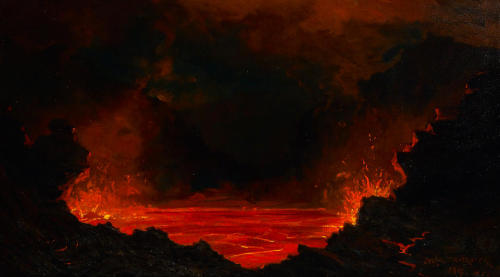
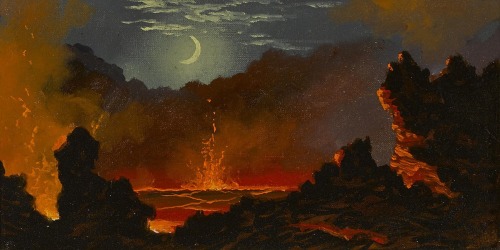
Portraits of Kilauea Volcano by Jules Tavernier (1844-1889)
Tavernier was a French painter who was fascinated by Hawaii’s awe-inspiring fiery volcanoes. To reach Kilauea in the 1800s, one would have to make a difficult 3 day journey by horseback. Despite this, Tavernier called the place “an artist’s paradise.”
How is Biotechnology Preparing us to Live on the Moon and Mars?
The adventures awaiting astronauts on future long-duration missions have technologists researching sustainable ways to live away from Earth. We’re using what we know from almost 20 years of a continuous human presence on the International Space Station and looking at new technologies to prepare for extended stays on the Moon and Mars.

Biotechnology – technology that uses living organisms to make products that provide a new use – is key to this research.
With biotechnology, we’re developing new ways to manufacture medicines, build habitats and more in space. Here are some ways biotechnology is advancing spaceflight and how the same research is reaping benefits on Earth.

Healthy astronauts
Planning ways to supply food for a multi-year mission on the Moon or Mars may require making food and nutrients in space. Our scientists are testing an early version of a potential solution: get microorganisms to produce vital nutrients like those usually found in vegetables. Then, whenever they’re needed, astronauts can drink them down.
The microorganisms are genetically engineered to rapidly produce controlled quantities of essential nutrients. Because the microorganisms and their food source both have a long shelf-life at room temperature and only need water to be activated, the system provides a simple, practical way to produce essential nutrients on-demand. The same kind of system designed for space could also help provide nutrition for people in remote areas of our planet.
Our researchers are evaluating the first batches of BioNutrient samples that came back to Earth after an experimental run on the International Space Station.

Because space travel takes a toll on the human body, we’re also researching how biotechnology can be used to advance the field of regenerative medicine.
Related cells that are joined together are collectively referred to as tissue, and these cells work together as organs to accomplish specific functions in the human body. Blood vessels around the cells vascularize, providing nutrients to the tissue to keep it healthy.
Our Vascular Tissue Challenge offers a $500,000 prize to be divided among the first three teams that successfully create thick, metabolically-functional human vascularized organ tissue in a controlled laboratory environment. The vascularized, thick-tissue models resulting from this challenge will function as organ analogs, or models, that can be used to study deep space environmental effects, such as radiation, and to develop strategies to minimize the damage to healthy cells.
Plant factories
Humans have relied on plants’ medicinal qualities for thousands of years for everything from alleviating minor ailments to curing serious diseases. Now, researchers are trying to simplify the process of turning plants into medicine (i.e. how to make it compact and portable). If successful, the cost of biomanufacturing pharmaceuticals on Earth could go down, and plants could produce medicines in space.

Creating medicine on demand isn’t something we typically do, so we’re turning to experts in the field for help. Researchers at the University of California, Davis are transforming plants into mini-medicine factories for future Mars missions. They’re genetically altering an ordinary type of lettuce so that it produces a protein called parathyroid hormone. This hormone is an approved drug for treating osteoporosis, a common condition where bones become weak and brittle.

This type of research is vital to long duration spaceflight. When astronauts land on Mars, they’ll need to be strong—ready to explore. The length of the flight in zero gravity to get there and lower gravity on the surface could have a negative impact on human bones. Having the technologies needed to treat that possibility, and other unanticipated health effects of long duration spaceflight, is crucial.
Growing habitats
Vitamins aren’t the only thing astronauts could be growing on Mars; we’re exploring technologies that could grow structures out of fungi.
An early-stage research project underway at our Ames Research Center is prototyping technologies that could “grow” habitats on the Moon, Mars and beyond out of life – specifically, fungi and the unseen underground threads that make up the main part of the fungus. These tiny threads build complex structures with extreme precision, networking out into larger structures like mushrooms. With the right conditions, they can be coaxed into making new structures – ranging from a material similar to leather to the building blocks for a planetary home.
The myco-architecture project envisions a future where astronauts can construct a habitat out of the lightweight fungi material. Upon arrival, by unfolding a basic structure made up of dormant fungi and simply adding water, the fungi would grow around that framework into a fully functional human habitat – all while being safely contained to avoid contaminating the external environment.

Recycling waste
Once astronauts arrive on the surface of the Moon or a more distant planet, they’ll have to carefully manage garbage. This waste includes some stuff that gets flushed on Earth.
Today, we’re already using a recycling system on the space station to turn urine into drinking water. Poop on the other hand is contained then disposed of on spacecraft returning to Earth. That won’t be possible on more distant journeys, so, we’re turning to biomanufacturing for a practical solution.
Biology can serve as an effective recycling factory. Microorganisms such as yeast and algae feed on all kinds of things classified as “mission waste.” Processing their preferred form of nourishment generates products that can serve as raw materials used to make essential supplies like nutrients, medicines, plastic and fuel.

By taking a careful look at biological processes, we hope to develop new, lightweight systems to leverage that biology to do some helpful in-space manufacturing.
From Space to Earth
Biotechnology is preparing us for longer space missions to the Moon and then Mars – farther from Earth than humans have ever traveled before. As we prepare for those exciting missions, we’re also conducting research on the space station for the primary benefit of everyone on Earth.
January is National Biotechnology Month. To learn more about some of the ways NASA is using biotechnology to solve challenges in space and improve life on Earth, visit this link.
Make sure to follow us on Tumblr for your regular dose of space: http://nasa.tumblr.com
How the media depicts the Apollo 11 mission:
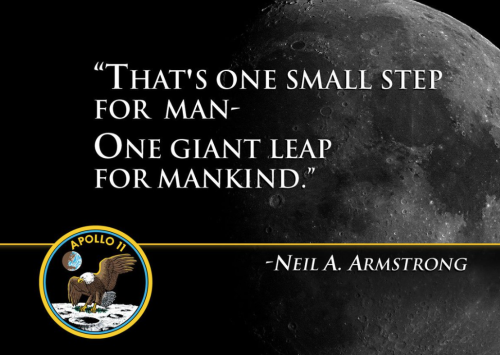
Actual quotes from the Apollo 11 mission:













Notes on cartography by American cartographer, Erwin Raisz (1893-1968). So neat and precise. This makes me want to draw maps.
I think these are all from Raisz’s 1962 book, PRINCIPLES OF CARTOGRAPHY.
This radiant Sodalite mineral rock. Tenebrescence is the ability of minerals to change colour when exposed to light.
Source
Scientists at the University of Minnesota put 3D glasses on cuttlefish, who then used stereo data to place themselves at a consistent distance from the illusionary expected 3D location of the prey.
What can you see from the space station? Can you see stars, the moon and sun, and Earth weather like lightening storms?
me, to my friend, out of no where: You know whats fucked uP? the volcanology scale. Have i told you about the volcanic explosivity index?
my friend: no? What?!
me: Isnt it fun how catastrophic is only the halfway point on this exponential scale of eruption severity

the fact that we can map sedimentary units from space is really cool and also Mars is cool!
what was the name of the fish my geology teacher called “bad dude” because i put bad dude in my notes and have no idea what the real name is
Fun fact: the guys at our college’s geology department prop out the doors with their samples. I totally understand why but as someone whose work with samples is necessarily super delicate and sterile it fucks me up so bad
